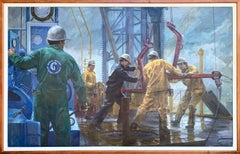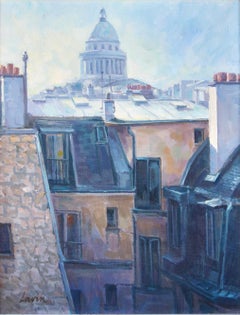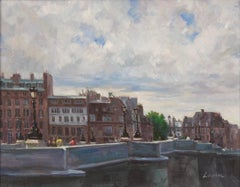Robert Lavin Art
to
8
8
1
Dealer: Austin Galleries
Global Marine Oil Workers on and Offshore Rig
By Robert Lavin
Located in Austin, TX
"Global Marine Oil Workers"
Artist: Robert Lavin
Medium: Oil on Canvas
Size: 39" x 64"
Framed
In 1980, Charles Russel Luigs, CEO of Global Marine Inc. commissioned painter Robert La...
Category
20th Century Robert Lavin Art
Materials
Canvas, Oil
Dawn at the Capital
By Robert Lavin
Located in Austin, TX
Title: Dawn at the Capital
Artist: Robert Lavin
Medium: Oil on canvas
Size: 18" x 14"
Framed
Category
20th Century Robert Lavin Art
Materials
Canvas, Oil
Paris
By Robert Lavin
Located in Austin, TX
Title: "Paris"
Artist: Robert Lavin
Medium: Oil Paint on Canvas
Size: 14" x 18"
Framed
Category
20th Century Robert Lavin Art
Materials
Canvas, Oil
Cordoba
By Robert Lavin
Located in Austin, TX
Title: "Cordoba"
Artist: Robert Lavin
Medium: Oil Paint on Canvas
Size: 20" x 30"
Framed
Category
20th Century Robert Lavin Art
Materials
Canvas, Oil
House
By Robert Lavin
Located in Austin, TX
Title: "House"
Artist: Robert Lavin
Medium: Oil on Canvas
Size: 11" x 16"
Category
20th Century Robert Lavin Art
Materials
Canvas, Oil
"Shipyard" Realist Industrial Landscape
By Robert Lavin
Located in Austin, TX
This painting is a 20th century realist landscape depiction of a shipyard by Robert Lavin. The piece is executed in oil on board and measures 10" x 24".
Robert Lavin was born in New York City. His education included Townsend Harris, a prep school in New York followed by college at City College of New York. He also attended the National Academy of Art, where he studied as a painter. Studying the social realists of the 1930’s, Lavin, a former Marine pilot, portrayed steelworkers, roughnecks and trainmen. Lavin often painted his “proletarian ballets”- as one critic called them – to illustrate magazine advertisements.
The Smithsonian Institution and other museums collected Lavin’s original paintings, which portrayed the laboring subjects with dignity and integrity. Lavin also illustrated stock certificates and books. Paper Money magazine praised him as “one of the greatest vignette artists of the 20th century.” In addition to this, Lavin was for a number of years an Associate Professor of Art at City College of New York, a position he left in the mid ‘60’s in order to devote himself full time to his painting. His commissions took him around the world, from the North Sea to the coast of Africa, from the slopes of Alaska to the Sea of Japan. As part of a series for Gulf Oil, he painted the royal family of England for the opening of a new refinery in Wales. Another portrait of one of the early Americanastronauts, appeared on the cover of Time Magazine. Other major commissions during these years included Readers Digest books...
Category
20th Century American Realist Robert Lavin Art
Materials
Oil, Board
Hanging the Transformers
By Robert Lavin
Located in Austin, TX
Robert "Bob" Lavin
Title: "Hanging the Transformers"
Medium: Oil on Canvas
Size: 32" x 20"
Framed: 36.5" 23.5"
Marking: Hand-Signed LR "Lavin"
In Bob Lavin's Original Frame
Category
20th Century American Realist Robert Lavin Art
Materials
Canvas, Oil
Building the Space Simulator
By Robert Lavin
Located in Austin, TX
Robert "Bob" Lavin (1919 - 1997)
Title: "Building the Space Simulator"
Medium: Oil on Canvas
Size: 27.25" x 23.25"
Framed
Markings: Signed LR "Bob Lavin"
Category
Late 20th Century American Realist Robert Lavin Art
Materials
Canvas, Oil
Related Items
Young woman portrait with a white bow
Located in BELEYMAS, FR
Charles HERMANN-LÉON (born Léon Charles Sigismond HEMRMANN)
(Le Havre 1838 - Paris 1908)
Portrait of a young woman
Oil on canvas
H. 54 cm; L. 41 cm
Signed and dated upper right - 187...
Category
1870s French School Robert Lavin Art
Materials
Oil, Canvas
Monuments: Sunrise, 1950s Southwestern Desert Landscape Oil Painting, 24 x 30 in
By Harold Vincent Skene
Located in Denver, CO
'Monuments: Sunrise', original vintage 1950s oil painting of a southwestern desert landscape in early morning with rock formations, trees and brush with brilliant sky with clouds by ...
Category
1950s American Realist Robert Lavin Art
Materials
Board, Oil
Portrait of singer Adelina Patti - L. Frossard - Opera
Located in BELEYMAS, FR
L. FROSSARD
(active in Vienna around 1870)
Portrait of Adelina Patti (1843-1919)
Oil on canvas
H. 100.5 cm; L. 73.5 c
Signed lower left
If the artist maintains a certain discretion ...
Category
1860s French School Robert Lavin Art
Materials
Canvas, Oil
Early oil depicting the Great Fire of London
Located in London, GB
The Great Fire of London in September 1666 was one of the greatest disasters in the city’s history. The City, with its wooden houses crowded together in narrow streets, was a natural fire risk, and predictions that London would burn down became a shocking reality. The fire began in a bakery in Pudding Lane, an area near the Thames teeming with warehouses and shops full of flammable materials, such as timber, oil, coal, pitch and turpentine. Inevitably the fire spread rapidly from this area into the City. Our painting depicts the impact of the fire on those who were caught in it and creates a very dramatic impression of what the fire was like. Closer inspection reveals a scene of chaos and panic with people running out of the gates. It shows Cripplegate in the north of the City, with St Giles without Cripplegate to its left, in flames (on the site of the present day Barbican). The painting probably represents the fire on the night of Tuesday 4 September, when four-fifths of the City was burning at once, including St Paul's Cathedral. Old St Paul’s can be seen to the right of the canvas, the medieval church with its thick stone walls, was considered a place of safety, but the building was covered in wooden scaffolding as it was in the midst of being restored by the then little known architect, Christopher Wren and caught fire. Our painting seems to depict a specific moment on the Tuesday night when the lead on St Paul’s caught fire and, as the diarist John Evelyn described: ‘the stones of Paul’s flew like grenades, the melting lead running down the streets in a stream and the very pavements glowing with the firey redness, so as no horse, nor man, was able to tread on them.’
Although the loss of life was minimal, some accounts record only sixteen perished, the magnitude of the property loss was shocking – some four hundred and thirty acres, about eighty per cent of the City proper was destroyed, including over thirteen thousand houses, eighty-nine churches, and fifty-two Guild Halls. Thousands were homeless and financially ruined. The Great Fire, and the subsequent fire of 1676, which destroyed over six hundred houses south of the Thames, changed the appearance of London forever. The one constructive outcome of the Great Fire was that the plague, which had devastated the population of London since 1665, diminished greatly, due to the mass death of the plague-carrying rats in the blaze.
The fire was widely reported in eyewitness accounts, newspapers, letters and diaries. Samuel Pepys recorded climbing the steeple of Barking Church from which he viewed the destroyed City: ‘the saddest sight of desolation that I ever saw.’ There was an official enquiry into the causes of the fire, petitions to the King and Lord Mayor to rebuild, new legislation and building Acts. Naturally, the fire became a dramatic and extremely popular subject for painters and engravers. A group of works relatively closely related to the present picture have been traditionally ascribed to Jan Griffier...
Category
17th Century Old Masters Robert Lavin Art
Materials
Oil, Canvas
19th century portrait painted in St Petersburg in 1819
Located in London, GB
Signed, inscribed and dated, lower right:
'Geo Dawe RA St Petersburgh 1819', also signed
with initials, lower centre: 'G D RA'; and signed and inscribed verso:
'Geo Dawe RA Pinxit 1819 St Petersburgh';
Also inscribed on the stretcher by Cornelius Varley with varnishing instructions.
Collections:
Private collection, UK, 2010
Literature:
Galina Andreeva Geniuses of War, Weal and Beauty: George Dawe...
Category
19th Century Old Masters Robert Lavin Art
Materials
Canvas, Oil
Two royal portraits (the Duc d'Angoulême and the Duc de Berry) by H.P. Danloux
Located in PARIS, FR
These two royal portraits are a major historical testimony to the stay of the Comte d'Artois (the future Charles X) and his family in Edinburgh in 1796-1797. Given by the sitters to Lord Adam Gordon, the Governor of Edinburgh, and kept by family descent to this day, these two portraits provide us with a vivid and spontaneous image of the Duc d’Angoulême and his brother the Duc de Berry. Danloux, who had emigrated to London a few years before, demonstrate his full assimilation of the art of British portrait painters in the brilliant execution of these portraits.
1. Henri-Pierre Danloux, a portraitist in the revolutionary turmoil
Born in Paris in 1753, Henri-Pierre Danloux was first a pupil of the painter Nicolas-Bernard Lépicié (1735 - 1784) and then, in 1773, of Joseph-Marie Vien (1716 - 1809), whom he followed to Rome when, at the end of 1775, Vien became Director of the Académie de France. In Rome he became friends with the painter Jacques-Louis David (1748 - 1825).
Returning to France around 1782, he settled in Lyon for a few years before returning to Paris in 1785. One of his first portraits was commissioned by the Baroness d'Etigny, the widow of the former Intendant of the Provinces of Gascony, Bearn and Navarre Antoine Mégret d'Etigny (1719 – 1767). He then became close to his two sons, Mégret de Sérilly and Mégret d'Etigny, who in turn became his patrons. In 1787, this close relationship with the d'Etigny family was further strengthened by his marriage to Antoinette de Saint-Redan, a relative of Madame d'Etigny. After his marriage, he left for Rome and did not return to France until 1789. It was during the winter of 1790-1791 that he painted one of his masterpieces, the portrait of Baron de Besenval. Set in a twilight atmosphere, this portrait of an aristocrat who knows that his death is imminent symbolizes the disappearance of an erudite and refined society which would be swept away by the French Revolution.
The Jacobin excesses led Danloux to emigrate to England in 1792; many members of his family-in-law who remained in France were guillotined on 10 May 1794. Danloux enjoyed great success as a portrait painter in England before returning to France in 1801.
During his stay in England, Danloux was deeply under the influence of English portraitists: his colors became warmer (as shown by the portrait of the Duc d'Angoulême that we are presenting), and his execution broader.
2. Description of the two portraits and biographical details of the sitters
The Duc d'Angoulême (1775-1844) was the eldest son of the Comte d'Artois, the younger brother of King Louis XVI (the future King Charles X), and his wife Marie-Thérèse of Savoie. He is shown here, in the freshness of his youth, wearing the uniform of colonel-general of the "Angoulême-Dragons" regiment.
He is wearing the blue cordon of the Order of the Holy Spirit, which was awarded to him in 1787, and two decorations: the Cross of Saint-Louis and the Maltese Cross, as he was also Grand Prior of the Order of Malta.
Born on 16 August 1775 in Versailles, Louis-Antoine d'Artois followed his parents into emigration on 16 July 1789. In 1792, he joined the émigrés’ army led by the Prince de Condé. After his stay in Edinburgh (which will be further discussed), he went to the court of the future King Louis XVIII, who was in exile at the time, and in 1799 married his first cousin Marie-Thérèse Charlotte of France, the daughter of Louis XVI and the sole survivor of the royal family. The couple had no descendants. He became Dauphin of France in 1824, upon the accession to the throne of his father but played only a minor political role, preferring his military position as Grand Admiral. Enlisted in Spain on the side of Ferdinand VII, he returned home crowned with glory after his victory at Trocadero in 1823.
He reigned for a very short time at the abdication of Charles X in 1830, before relinquishing his rights in favor of his nephew Henri d'Artois, the Duc de Bordeaux. He then followed his father into exile and died on 3 June 1844 in Gorizia (now in Italy).
His younger brother, the Duc de Berry, is shown in the uniform of the noble cavalry of the émigrés’ Army. He is wearing the blue cordon of the Order of the Holy Spirit, awarded to him in May 1789, and the Cross of Saint-Louis (partly hidden by his blue cordon).
Born on 24 January 1778 in Versailles, Charles-Ferdinand d'Artois also followed his parents into emigration and joined the émigrés’ army in 1792. After his stay in Edinburgh, he remained in Great Britain, where he had an affair with Amy Brown...
Category
1790s Old Masters Robert Lavin Art
Materials
Canvas, Oil, Wood Panel
Woman with Lobsters / "Femme et Homards"
By Andre Minaux
Located in Berlin, MD
Andre Minaux (French 1923 - 1986) "Femme et Homards" / Woman with Lobsters. Oil on canvas. Features a young woman holding one lobster while two others sit on a counter before her. ...
Category
Mid-20th Century French School Robert Lavin Art
Materials
Cotton Canvas, Oil
Portrait Johann Theodor Bavaria, Son of Prince Elector, by Joseph Vivien, Rococo
By Joseph Vivien
Located in Greven, DE
Portrait of Johann Theodor of Bavaria (1703-1763)
by Joseph Vivien
Johann Theodor of Bavaria (* September 3, 1703 in Munich; † January 27, 1763 in Lièg...
Category
18th Century Rococo Robert Lavin Art
Materials
Canvas, Oil
Contemporary Oil of Psychic Reading, Tarot Card, and Palm Reading Neon Sign
Located in Fort Worth, TX
Paper, 2020, Daniel Blagg, Oil on canvas, 38 x 58"
By meticulously depicting forgotten road signs and roadside debris, Daniel Blagg invites his viewers to re-consider objects that ...
Category
2010s American Realist Robert Lavin Art
Materials
Canvas, Acrylic, Oil
H 38 in W 58 in D 2.5 in
François-Joseph Kinson - Young woman portrait with her dog
By Francois Kinsoen (Kinson)
Located in BELEYMAS, FR
François-Joseph KINSON
(Bruges 1770 – Bruges 1839)
Portrait of a young woman near a spring, accompanied by her dog
Oil on canvas
H. 73 cm; L. 60 cm
circa 1815-1817
We owe this elegant portrait to François-Joseph Kinson from Bruges, which is still linked to the art of the First Empire. We find in this artist this type of pose that is a bit rigid, sometimes with a countryside in the background, and this way of treating costumes and faces. Thus the full-length portrait of Jenny...
Category
1810s French School Robert Lavin Art
Materials
Canvas, Oil
Women portrait (Coraline)
Located in BELEYMAS, FR
Auguste Adolphe CHAUVIN
(Liege, 1810 – Liege 1884)
Portrait of Coraline
Oil on canvas
Signed and dated lower right
91 x 68 cm
1868
Auguste Adolphe Chauvin, born in Liège on October ...
Category
1860s French School Robert Lavin Art
Materials
Canvas, Oil
Young girl reading
Located in BELEYMAS, FR
Alice BASTIDE
(Saint Mandé 1868 – Paris 1959)
Portrait of a little girl reading
Oil on canvas
H. 100 cm; L. 72.5 cm
Signed lower right and dated 1912
Daughter of a pastor from Gard and an English woman, Alice Bastide grew up in Paris. A pupil of the Jullian Academy, she began her apprenticeship under the guidance of Henri Royer and François Schommer. The development of his art is mainly oriented towards still lifes, without completely abandoning portraits and landscapes. Her other specialty for which she received numerous awards is miniatures. At the Salon of 1914 she received the Maxime David prize crowning the best piece while her finesse was already noticed by press critics from 1907. Coronation, in 1926 she received a gold medal at the Salon for her miniature Coquetterie. In 1896, the young woman married a man from Gard, Auguste Massebiaux, whose name she would occasionally bear. The latter, a lawyer at the Paris Court of Appeal, died in 1910. The couple had no children. At that time she was domiciled at 48 avenue d'Orléans (later named avenue du general Leclerc) in Paris where she lived until her death in 1959. Until the mid-1930s she continued to exhibit at the Salon des Artistes French with a manner very close to Impressionism, luminous and vigorous. In 1912, two years after the death of her husband, Alice Bastide was certainly still marked by the sadness of her mourning. The tones of our portrait of a little girl and the frame she puts together are dark and heavy. This child, wearing an embroidered bonnet, is bent over her book, her loose hair flowing over a red velvet indoor dress. This intimate portrait on a dark tapestry...
Category
1910s French School Robert Lavin Art
Materials
Oil, Canvas
Robert Lavin art for sale on 1stDibs.
Find a wide variety of authentic Robert Lavin art available for sale on 1stDibs. If you’re browsing the collection of art to introduce a pop of color in a neutral corner of your living room or bedroom, you can find work that includes elements of blue and other colors. You can also browse by medium to find art by Robert Lavin in oil paint, paint, canvas and more. Not every interior allows for large Robert Lavin art, so small editions measuring 2 inches across are available. Customers who are interested in this artist might also find the work of William Baptiste Baird, Peter Driben, and Saul Chase. Robert Lavin art prices can differ depending upon medium, time period and other attributes. On 1stDibs, the price for these items starts at $800 and tops out at $15,000, while the average work can sell for $3,500.







